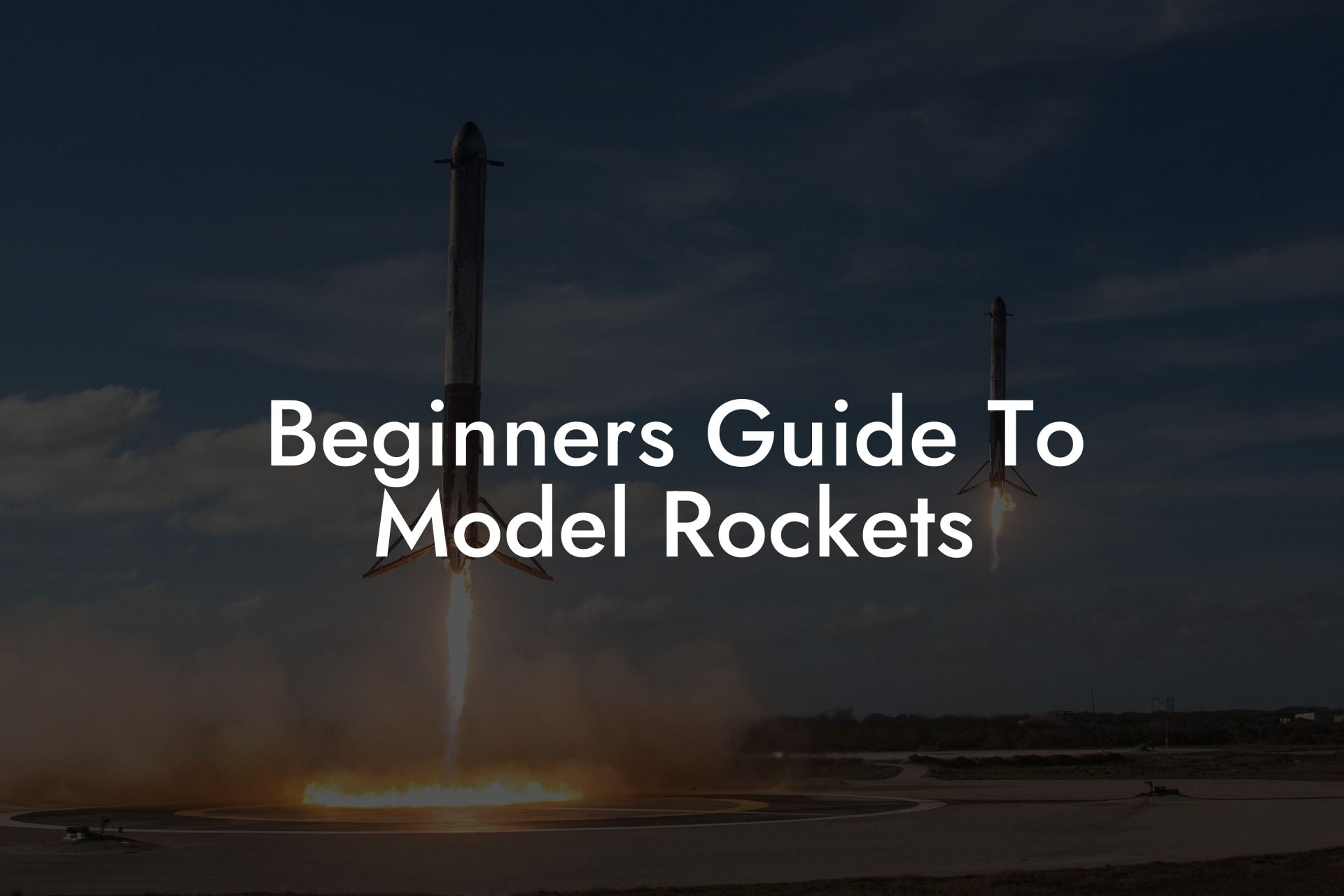Imagine soaring to new heights, defying gravity, and exploring the thrill of space travel without leaving the ground. Welcome to the world of model rockets, where the magic of aerospace engineering meets creativity and fun! Whether you're a curious beginner or a seasoned enthusiast, this comprehensive guide will blast off your journey into the exciting realm of model rocketry.
Quick Links to Useful Sections
What Are Model Rockets?
Model rockets are scaled-down versions of real rockets, designed to mimic the look, feel, and performance of their full-scale counterparts. They're typically made of lightweight materials like plastic, wood, or paper, and powered by small motors that produce a controlled thrust.
From simple, beginner-friendly kits to complex, high-performance models, the world of model rockets offers something for everyone. With a wide range of styles, sizes, and difficulty levels, you can choose the perfect rocket to suit your interests, skills, and budget.
The Benefits of Model Rocketry
Model rocketry is more than just a hobby – it's an educational journey that can ignite a passion for STEM fields (science, technology, engineering, and mathematics). By building and launching model rockets, you'll develop essential skills in:
- Problem-solving and critical thinking: Design, build, and troubleshoot your rocket to overcome challenges and achieve success.
- Physics and engineering principles: Learn about aerodynamics, propulsion systems, and the science behind rocket flight.
- Creativity and innovation: Express yourself through custom designs, paint schemes, and modifications.
- Teamwork and communication: Collaborate with fellow enthusiasts, share knowledge, and learn from each other's experiences.
Plus, model rocketry is an excellent way to develop patience, perseverance, and attention to detail – essential life skills that will benefit you far beyond the launchpad.
Looking For The Best Model Rocket Kits? You'll Love These:
Getting Started with Model Rockets
Ready to embark on your model rocketry journey? Here's a step-by-step guide to help you get started:
- Choose a kit or design: Select a beginner-friendly kit or design your own rocket using online resources and tutorials.
- Gather materials and tools: Acquire the necessary materials, such as balsa wood, plastic, or paper, and basic tools like glue, scissors, and sandpaper.
- Assemble and customize: Follow the kit instructions or your design plan to build and customize your rocket.
- Obtain a launch system: Invest in a launch pad, launch rod, and recovery system to ensure safe and successful launches.
- Find a safe launch site: Identify a suitable location with open space, minimal obstacles, and permission to launch model rockets.
Remember to always follow safety guidelines and local regulations when launching model rockets.
Types of Model Rockets
The world of model rockets is incredibly diverse, with various types catering to different interests and skill levels. Some popular categories include:
- Beginner rockets: Simple, easy-to-assemble kits perfect for newcomers to the hobby.
- Scale models: Accurate replicas of real rockets, often featuring intricate details and realistic designs.
- Competition rockets: High-performance models designed for speed, altitude, or duration competitions.
- Experimental rockets: Unique, custom designs that push the boundaries of model rocketry and innovation.
Explore different types of model rockets to find the one that suits your style and interests.
Tips and Tricks for Model Rocketry Success
To ensure a successful and enjoyable model rocketry experience, keep these expert tips in mind:
- Follow safety guidelines: Always wear protective gear, ensure a safe launch site, and follow local regulations.
- Read and follow instructions: Carefully read kit instructions, online tutorials, and safety guidelines to avoid mistakes.
- Practice patience and perseverance: Don't be discouraged by setbacks – model rocketry is a learning process.
- Join a community: Connect with fellow enthusiasts online or in-person to share knowledge, resources, and experiences.
By following these tips and staying committed to your craft, you'll be well on your way to becoming a skilled model rocketeer.
Resources and Community Support: Your Next Steps
Now that you've started your model rocketry journey, it's essential to stay connected with the community and access valuable resources:
- Online forums and social media groups: Join platforms like Reddit's r/modelrockets, Facebook groups, and online forums to connect with enthusiasts.
- Local model rocket clubs: Search for clubs in your area to meet fellow enthusiasts, share knowledge, and participate in launches.
- Model rocketry websites and blogs: Visit websites like the National Association of Rocketry (NAR) and The Rocketry Blog for tutorials, news, and resources.
- Books and tutorials: Explore instructional books, online tutorials, and YouTube channels to improve your skills and knowledge.
Stay engaged, keep learning, and most importantly, have fun!
Frequently Asked Questions: Model Rocketry 101
Here are some frequently asked questions to help you get started with model rocketry:
1. What is the best model rocket for a beginner?
Look for a simple, easy-to-assemble kit with a gentle learning curve, such as the Estes Tandem-X or the Apogee model rocket Kit.
2. How high can model rockets fly?
Depending on the design and motor, model rockets can reach altitudes ranging from a few hundred feet to several thousand feet.
3. Are model rockets safe?
Yes, when used properly and following safety guidelines, model rockets are safe and enjoyable.
4. Can I build my own model rocket from scratch?
Absolutely! With some creativity, patience, and online resources, you can design and build your own custom model rocket.
5. How do I recover my model rocket after launch?
Use a recovery system, such as a parachute or streamer, to slow down the rocket's descent and ensure a safe landing.
Looking For The Best Model Rocket Kits? You'll Love These:
Useful Interruption: Dive deeper into the world of Model Rockets with our most popular sections. If there is anything you think is missing or anything you would love for us to write about, just give us a shout.
- Getting Started & Basics With Model Rockets
- Model Rocket Design, Build & Customization
- Model Rocket Propulsion & Engine Technology
- Model Rocket Launch Techniques & Recovery
- Model Rocket Advanced Rocketry & Innovations
- Model Rocket DIY and Customization
- Model Rocket Equipment Reviews & Digital Tools
- Community, Competitions & Education
- Model Rocket Troubleshooting & FAQs
- Model Rocket Bonus/Seasonal & Niche Topics
A group of model rocket enthusiasts gathered at a field for their weekly launch event. Among them was Dave, a seasoned builder known for pushing the limits of hobby rocketry. This time, he had outdone himself.
“Ladies and gentlemen,” Dave announced, dramatically pulling a cloth off his latest creation, “I present to you: The Kraken!”
The crowd gasped. This wasn’t just a model rocket, it was a monster. The thing stood 8 feet tall, had six clustered engines, and was covered in enough duct tape to qualify as a classified aerospace project.
“Dave,” muttered Steve, the cautious safety officer, “Have you, uh… done the math on this?”
“Math?” Dave scoffed. “I built it in my garage at 3 a.m. with parts from eBay. This is an art piece, Steve.”
The countdown began.
5…
4…
3…
2…
1…
The engines ignited with a BOOM, and The Kraken shot up… kind of. It immediately did a violent barrel roll, narrowly missing the spectators before skyrocketing at an angle that could only be described as “legally questionable.”
The crowd collectively ducked as The Kraken flew straight over the adjacent cornfield, where Old Man Jenkins, the grumpiest farmer in town, was minding his business.
KABOOM!
The rocket disappeared behind the barn. A moment later, a flaming piece of Estes igniter wire landed at Steve’s feet. The silence was deafening.
And then, an unmistakable sound echoed across the field.
Jenkins’ shotgun being cocked.
“DAVE!!!” Steve shouted. “RUN.”
And that was the day Dave invented the first-ever biologically powered rocket booster: pure adrenaline.
To this day, nobody knows where The Kraken landed, but legend has it, it still haunts the skies, terrifying unsuspecting drones and low-flying birds.















